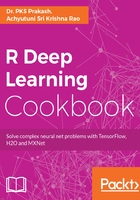
上QQ阅读APP看书,第一时间看更新
How it works...
The performance of the model can be evaluated using AUC:
# Performance on Train
library(pROC)
ypred <- sess$run(tf$nn$sigmoid(multilayer_perceptron(x, weights, biases)))
roc_obj <- roc(occupancy_train[, yFeatures], as.numeric(ypred))
# Performance on Test
nRowt<-nrow(occupancy_test)
xt <- tf$constant(unlist(occupancy_test[, xFeatures]), shape=c(nRowt, nFeatures), dtype=np$float32) #
ypredt <- sess$run(tf$nn$sigmoid(multilayer_perceptron(xt, weights, biases)))
roc_objt <- roc(occupancy_test[, yFeatures], as.numeric(ypredt))
AUC can be visualized using the plot.auc function from the pROC package, as shown in the image following the next command. The performance of train and test (hold out) is very similar.
plot.roc(roc_obj, col = "green", lty=2, lwd=2)
plot.roc(roc_objt, add=T, col="red", lty=4, lwd=2)

Performance of multilayer perceptron using TensorFlow